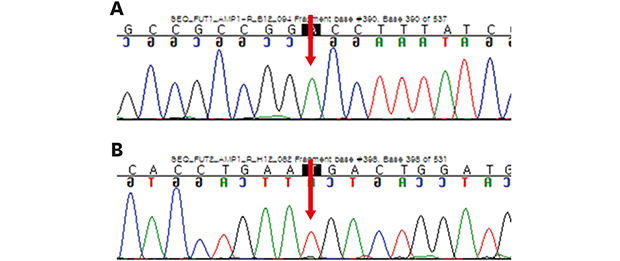1. Kelly RJ, Ernst LK, Larsen RD, Bryant JG, Robinson JS, Lowe JB. Molecular basis for H blood group deficiency in Bombay (Oh) and para-Bombay individuals. Proc Natl Acad Sci U S A. 1994; 91(13):5843–5847.

2. Kelly RJ, Rouquier S, Giorgi D, Lennon GG, Lowe JB. Sequence and expression of a candidate for the human Secretor blood group alpha(1,2)fucosyltransferase gene (FUT2). Homozygosity for an enzyme-inactivating nonsense mutation commonly correlates with the non-secretor phenotype. J Biol Chem. 1995; 270(9):4640–4649.
3. Larsen RD, Ernst LK, Nair RP, Lowe JB. Molecular cloning, sequence, and expression of a human GDP-L-fucose:beta-D-galactoside 2-alpha-L-fucosyltransferase cDNA that can form the H blood group antigen. Proc Natl Acad Sci U S A. 1990; 87(17):6674–6678.

4. Rouquier S, Lowe JB, Kelly RJ, Fertitta AL, Lennon GG, Giorgi D. Molecular cloning of a human genomic region containing the H blood group alpha(1,2)fucosyltransferase gene and two H locus-related DNA restriction fragments. Isolation of a candidate for the human Secretor blood group locus. J Biol Chem. 1995; 270(9):4632–4639.
5. Bhende YM, Deshpande CK, Bhatia HM, Sanger R, Race RR, Morgan WT, et al. A “new” blood group character related to the ABO system. Lancet. 1952; 1(6714):903–904.
6. Er TK, Yang TC, Liu YH. Heterozygous FUT1 mutations causing a para-Bombay phenotype. Clin Lab. 2018; 64(10):1787–1789.
7. Shrivastava M, Navaid S, Peethambarakshan A, Agrawal K, Khan A. Detection of rare blood group, Bombay (Oh) phenotype patients and management by acute normovolemic hemodilution. Asian J Transfus Sci. 2015; 9(1):74–77.

8. Yan L, Zhu F, Xu X, Hong X, Lv Q. Molecular basis for para-Bombay phenotypes in Chinese persons, including a novel nonfunctional FUT1 allele. Transfusion. 2005; 45(5):725–730.
9. Yip SP, Chee KY, Chan PY, Chow EY, Wong HF. Molecular genetic analysis of para-Bombay phenotypes in Chinese: a novel non-functional FUT1 allele is identified. Vox Sang. 2002; 83(3):258–262.

10. Zanjani DS, Afzal Aghaee M, Badiei Z, Mehrasa R, Roodsarabi A, Khayyami ME, et al. Molecular basis of Bombay phenotype in Mashhad, Iran: identification of a novel FUT1 deletion. Vox Sang. 2016; 111(1):88–92.

11. Garratty G. Immunobiology of Transfusion Medicine. Boca Raton, FL: CRC Press;1993.
12. Simon TL, McCullough J, Snyder EL, Solheim BG, Strauss RG. Rossi's Principles of Transfusion Medicine. 4th ed. Oxford: Wiley-Blackwell;2009.
13. Dipta TF, Hossain AZ. The Bombay blood group: are we out of risk? Mymensingh Med J. 2011; 20(3):536–540.
14. Kaneko M, Nishihara S, Shinya N, Kudo T, Iwasaki H, Seno T, et al. Wide variety of point mutations in the H gene of Bombay and para-Bombay individuals that inactivate H enzyme. Blood. 1997; 90(2):839–849.

15. Yu LC, Yang YH, Broadberry RE, Chen YH, Lin M. Heterogeneity of the human H blood group alpha(1,2)fucosyltransferase gene among para-Bombay individuals. Vox Sang. 1997; 72(1):36–40.
16. He Z, Liu F. Two Novel α 1,2-Fucosyltransferase Alleles in an H-Deficient Phenotype Individual. Transfus Med Hemother. 2014; 41(5):375–379.
18. Liu Y, Koda Y, Soejima M, Pang H, Schlaphoff T, du Toit ED, et al. Extensive polymorphism of the FUT2 gene in an African (Xhosa) population of South Africa. Hum Genet. 1998; 103(2):204–210.

19. Soejima M, Pang H, Koda Y. Genetic variation of FUT2 in a Ghanaian population: identification of four novel mutations and inference of balancing selection. Ann Hematol. 2007; 86(3):199–204.







 PDF
PDF Citation
Citation Print
Print





 XML Download
XML Download